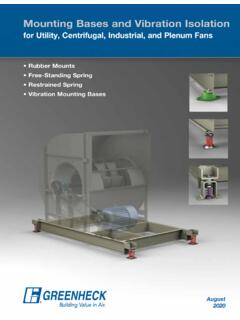Transcription of RANDOM VIBRATION—AN OVERVIEW by Barry Controls, …
1 RANDOM vibration AN OVERVIEW by Barry Controls, Hopkinton, MA ABSTRACT RANDOM vibration is becoming increasingly recognized as the most realistic method of simulating the dynamic environment of military applications. Whereas the use of RANDOM vibration specifications was previously limited to particular missile applications, its use has been extended to areas in which sinusoidal vibration has historically predominated, including propeller driven aircraft and even moderate shipboard environments. These changes have evolved from the growing awareness that RANDOM motion is the rule, rather than the exception, and from advances in electronics which improve our ability to measure and duplicate complex dynamic environments.
2 The purpose of this article is to present some fundamental concepts of RANDOM vibration which should be understood when designing a structure or an isolation system. 2 of 15 INTRODUCTION RANDOM vibration is somewhat of a misnomer. If the generally accepted meaning of the term " RANDOM " were applicable, it would not be possible to analyze a system subjected to " RANDOM " vibration . Furthermore, if this term were considered in the context of having no specific pattern ( , haphazard), it would not be possible to define a vibration environment, for the environment would vary in a totally unpredictable manner.
3 Fortunately, this is not the case. The majority of RANDOM processes fall in a special category termed stationary. This means that the parameters by which RANDOM vibration is characterized do not change significantly when analyzed statistically over a given period of time - the RMS amplitude is constant with time. For instance, the vibration generated by a particular event, say, a missile launch, will be statistically similar whether the event is measured today or six months from today. By implication, this also means that the vibration would be statistically similar for all missiles of the same design.
4 It is possible to subdivide a process into a number of sub-processes, each of which could be considered to be stationary. For example, a missile environment could consist of several stationary processes, such as: captive carry, buffet, launch and free flight. Each of these sub-processes have unique amplitude, frequency and time characteristics, requiring separate analyses and considerations. The assumption of a stationary process is essential in both a technical and legal sense. As previously stated, it would not be possible for a designer to analyze a system, nor for a user to test a system prior to installation in the field, if the vibration excitation were not stationary.
5 Consequently, it would not be possible to develop a legally binding specification. In subsequent conversations, it is assumed that the RANDOM excitation is a stationary process. Any vibration is described by the time history of motion, where the amplitude of the motion is expressed in terms of displacement, velocity or acceleration. Sinusoidal vibration is the simplest motion, and can be fully described by straightforward mathematical equations. Figure 1 shows the amplitude time plot of a sinusoidal vibration , and indicates that sinusoidal vibration is cyclic and repetitive.
6 In other words, if frequency and amplitude (or time and amplitude) are defined, the motion can be predicted at any point in time. Figure 1. Amplitude-Time History of Sinusoidal vibration 3 of 15 A RANDOM vibration is one whose absolute value is not predictable at any point in time. As opposed to sinusoidal vibration , there is no well defined periodicity - the amplitude at any point in time is not related to that at any other point in time. Figure 2 shows the amplitude time history of a RANDOM vibration . The lack of periodicity is apparent.
7 A major difference between sinusoidal vibration and RANDOM vibration lies in the fact that for the latter, numerous frequencies may be excited at the same time. Thus structural resonances of different components can be excited simultaneously, the interaction of which could be vastly different from sinusoidal vibration , wherein each resonance would be excited separately. Figure 2. Amplitude-Time History of RANDOM vibration Although the instantaneous amplitude of a RANDOM vibration cannot be expressed mathematically as an exact function of time, it is possible to determine the probability of occurrence of a particular amplitude on a statistical basis.
8 To characterize a stationary process, an ensemble of possible time histories must be obtained, wherein the amplitude is measured over the frequency range of excitation. Thus, the three parameters of interest are: frequency, time and amplitude. This information would provide the ability to analyze a RANDOM process in a statistical sense. The characterization of RANDOM vibration typically results in a frequency spectrum of Power Spectral Density (PSD) or Acceleration Spectral Density (ASD), which designates the mean square value of some magnitude passed by a filter, divided by the bandwidth of the filter.
9 Thus, Power Spectral Desnity defines the distribution of power over the frequency range of excitation. The equipment designer is interested in avoiding mechanical failure and equipment malfunction. These may be produced by different mechanisms, requiring different methods of corrective action. To the designer, RANDOM vibration could be considered as either: a) an infinite number of harmonic vibrations with unpredictable amplitude and phase relationships in the frequency domain; or b) the sum of an infinite number of infinitesimal shocks occurring randomly in the time domain.
10 4 of 15 In the first case, response at a particular frequency may be the primary concern. For example, when a displacement sensitive device is excited at its natural frequency, relatively large displacements may result in malfunction. In such a case, the malfunction might be corrected by reducing the amplitude of excitation at the particular frequency of concern - the natural frequency of the device. This might be accomplished by inserting a vibration isolator between the source of excitation and the device. Alternatively, displacement might be reduced by adjusting the stiffness of the device, or by increasing damping at the natural frequency of the device.




